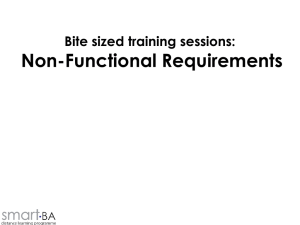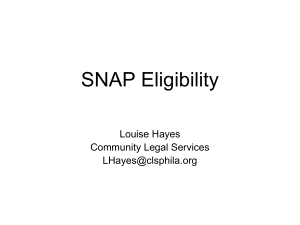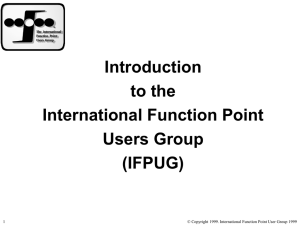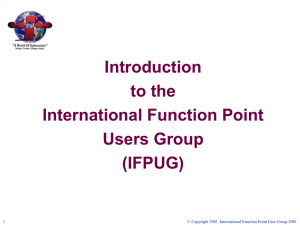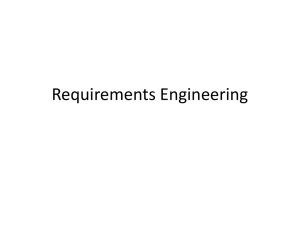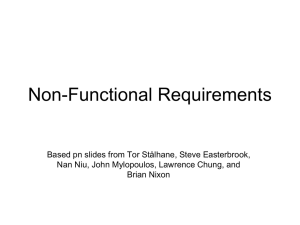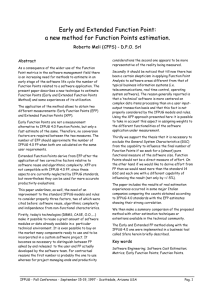Software Non-Functional Assessment Process
advertisement
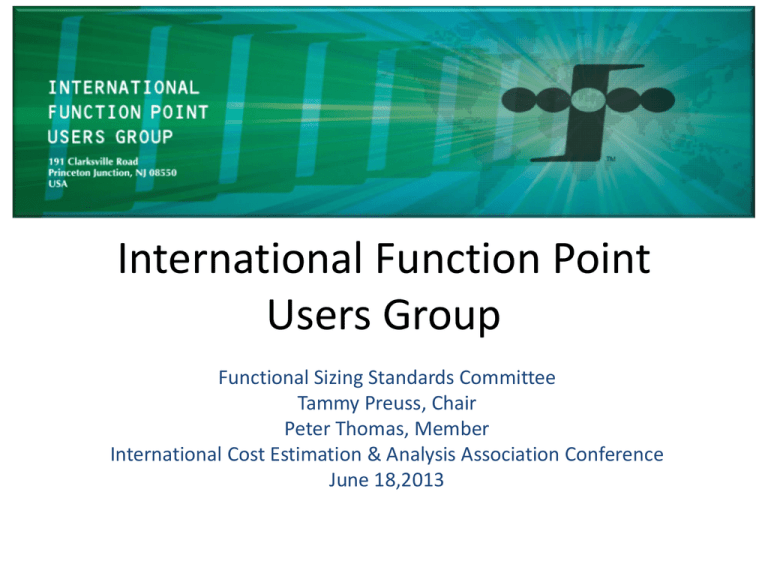
International Function Point Users Group Functional Sizing Standards Committee Tammy Preuss, Chair Peter Thomas, Member International Cost Estimation & Analysis Association Conference June 18,2013 Agenda Function Points Software Non-Functional Assessment Process Why use FP and SNAP methodologies? About IFPUG/ISMA Question/Answer Function Points • • • • Brief History What they are? How are they used? Why are they important to software measurement? Function Points Brief History 1979 • Developed by Alan Albrecht at IBM • A New Way of Looking at Tools • First Formal Function Point Guidelines • IFPUG elects first Board of Directors 1980s • Publication of Counting Practices Manual • Publication of Function Points as an Asset 1990s • Certified Function Point Specialist Certification • IFPUG FSM Method: ISO/IEC 20926:2009 Software and systems engineering - Software measurement - IFPUG functional size measurement method 2000s • CFPS certification test is automated • Publication of IFPUG Guide to IT & Software Measurements (2012) • • • Today • Counting Practices Manual v4.3.1 International Software Measurements Association Conference #8 in Rio de Janeiro, Brazil Special interest groups in Agile methodology & Cloud Working relationships with industry groups including TM Forum, CCC, ICEAA, OMG, NIST, ISBSG Function Points What are they? • Measuring functionality provided to the user based primarily on logical design. It is technology agnostic. • User can be a person using the system, another application, a system administrator, etc. Function Points Counting Process 1. Gather Available Documentation 2. Determine counting scope & boundaries. Identify functional user requirement 3. Measure Data Functions 4. Measure Transactional Functions 5. Calculate Functional Size 6. Document & Report Function Points Let’s Get Started Application Being Considered Other Applications • Gather documentation • Determine counting scope and boundary • Identify functional user requirements Function Points Measure Data Application Being Considered External Interface Files Internal Logical File Other Applications • ILF = Logical group of data maintained by the application • EIF = Logical group of data referenced but not maintained Function Points Measure Transactions External Input External Output External Inquiry Application Being Considered Internal Logical File External Interface Files External Input External Output Other External Inquiry Applications EI = Maintains ILF or passes control data into the application EO = data sent out of application with added value (e.g. calculated totals) EQ = External Inquiry (e.g. queries) Function Points Calculate Functional Size & Document Function Type Low Average High EI x3 x4 x6 EO x4 x5 x7 EQ x3 x4 x6 ILF x7 x 10 x 15 EIF x5 x7 x 10 Function Points Where are they used? • • • • • • Estimation Benchmarking Outsourcing Contracting Productivity Process Improvement Function Points Range of Price Per Function Point Note large variation and need to set “price” well above average Function Points View of ISBSG Benchmark data For several projects each meeting selection criteria Software Non-Functional Assessment Process • • • • Brief History What they are? How are they used? Why are they important to software measurement? Software Non-Functional Assessment Process Brief History 2007 2009 • IFPUG approval to ITPC for the project ‘Technical Sizing Framework’ • Goal: Define a framework covering technical aspects of software not covered by Function Points • IFPUG Software Non-functional Assessment Process Release 0.1 (Oct 2009) released 2010 • First Beta version released for pilot in industry • Post industry feedback SNAP APM Release 1.0 BETA released 2011 • Further beta testing in May 2011 across globe • SNAP APM Release 1.0 launched at ISMA 6 workshop Today • Beta tested in 10 countries and 18 organizations • APM updated with beta test results • SNAP APM Release 2.1 launched at April 2013 Software Non-Functional Assessment Process Why SNAP? Defines a framework that would size the Non-Functional/Technical aspects of software development. It provides a quantifiable measure for non-functional size of software development by means of documented guidance, definitions and practices about non-functional software features and related sizing criteria. This enables the organization to: – – – – Build better benchmarks Improve software estimation Demonstrate stronger correlation between software size & effort Better communicating NFR issues between stakeholders Software Non-Functional Assessment Process Counting Process 1. Determine Assessment Purpose, Scope & Boundary 2. Associate NonFunctional Requirements to Categories & Subcategories 3. Identify the SNAP Counting Units (SCU) 4. Determine Complexity of SCU 5. Calculate the SNAP points of the SCU 6. Calculate the NonFunctional Size Software Non-Functional Assessment Process Associate non-functional requirements to categories & sub-categories Data Operations • 1.1 Data Entry Validation Interface Design • 2.1 UI Changes Technical Environment Architecture • 3.1 Multiple Platforms • 4.1 Component based software • 3.2 Database Technology • 4.2 Multiple Input / Output Interfaces • 2.2 Help Methods • 1.2 Logical and Mathematical Operations • 1.3 Data Formatting • 1.4 Internal Data Movements • 1.5 Delivering Added Value to Users by Data Configuration • 2.3 Multiple Input Methods • 2.4 Multiple Output Methods • 3.3 Batch Processes Software Non-Functional Assessment Process SNAP Calculation Steps For each non-functional requirement, it is possible to determine the non-functional size in three steps 1. Identify the Snap Counting Unit (SCU). This is the unit of measurement for the subcategory such as elementary process, assessed application, user identified batch job. 2. Determine the non-functional size (SP) for each SCU within the sub category, by using the equations or the tables for the sub-categories 3. Determine the SP for a specific project or application by using the formula for the project type in question The SCU is a component or activity, in which complexity and size is assessed. The SCU can be a component, a process or an activity identified according to the nature of the sub-category/sub-categories. Software Non-Functional Assessment Process Analysis Steps NFR SNAP Cat 1 SNAP Cat 2 SNAP Cat 3 SNAP Cat 4 (Data Operations) (Interface Design) (Technical Environment) (Architecture) SCU = Elementary SCU = Assessed SCU = User Process (Data application (Help) identified batch Formatting) job (Batch Processes) SCU = Elementary Process (Multiple Inputs/Outputs) Rate complexity of SCU Rate complexity of SCU Rate complexity of SCU Rate complexity of SCU SNAP Points Software Non-Functional Assessment Process Example of Calculating SNAP Points Technical Environment: Multiple Platforms SCU = Elementary Process How many SNAP points does an application written in Cobol & Java with multiple browser support contribute to the count? Answer: 40 (Category 2) + 10 (Category 3) = 50 SP Why use both FP and SNAP methodologies? A requirement may contain both functional and non-functional aspects Functional size measured in Function Points; Non-functional size measured in SNAP Points Requirement should be broken into its functional and non-functional components The segregation should be agreed by both the users and developers Use FP for FR related tasks and SP for NFR related tasks Why use both FP and SNAP methodologies? – Increase Productivity – Improve Quality – Improve Processes – Measure Your Portfolio of Software Assets – Reduce Costs – Establish/Improve Your Software Metrics Program About IFPUG/ISMA • International Function Point Users Group – Volunteers who maintain the standards, publish materials to assist counters, and software measurement programs • www.ifpug.org – – – – Established in 1982 Headquarters in Princeton, New Jersey, USA Currently 1,200 members in 30 Countries Members are in AT&T, Steria, IBM, HP, Accenture, Booz Allen Hamilton, Northwestern Mutual, LG CNS, USMC, Banco Brandesco, Banco Central do Brasil, US Department of Defense, Semantys – International Software Measurement Association is IFPUG annual conference About IFPUG/ISMA Publications • Counting Practices Manual 4.3.1 www.ifpug.org • Assessment Practices Manual 2.1 www.ifpug.org • The IFPUG Guide to IT and Software Measurement by CRC Press – http://www.amazon.com/The-IFPUG-Guide-SoftwareMeasurement/dp/1439869308/ref=sr_1_1?ie=UTF8&qid=1364 527191&sr=81&keywords=IFPUG+guide+to+IT+and+Software+Measurement About IFPUG/ISMA International Software Measurement Conference #8 Co-located with the IT Confidence Conference October 1 – 2, 2013 Rio de Janeiro, Brazil Workshops, Presentations, Networking Sponsored by IFPUG & ISBSG Questions/Answers Come chat with us in the Exhibitor Hall! Contact information: Tammy Preuss tammy.preuss@att.com Peter Thomas peter3292004@gmail.com


